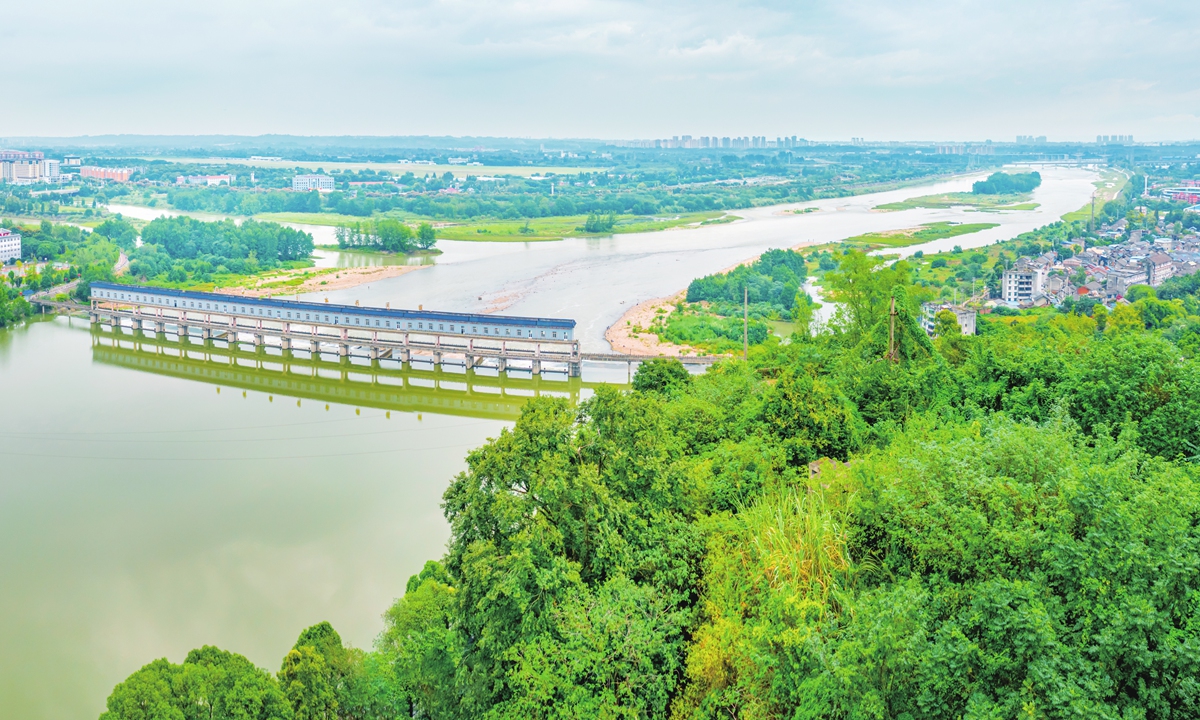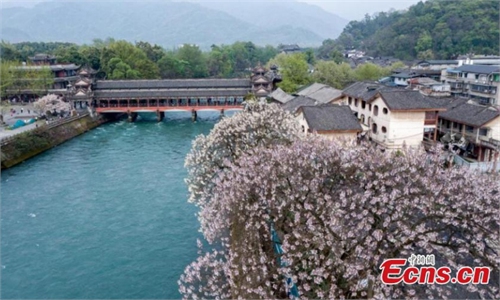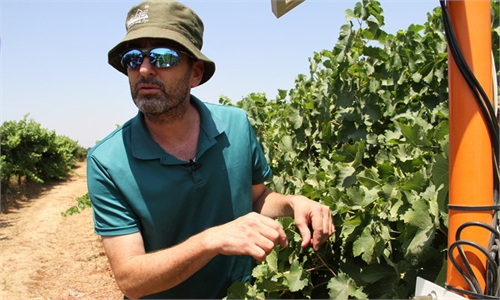ARTS / CULTURE & LEISURE
China’s historical irrigation sites serve as lessons for world
Ancient wisdom
Editor's Note:
Four Chinese historical irrigation sites were recognized as World Heritage Irrigation Structures, bringing the total number of such sites in China to 30, accounting for more than one fifth of the world's 140 sites, the International Commission on Irrigation and Drainage announced in Adelaide, Australia, on Thursday. The four sites - the Tongjiyan Irrigation System, Xinghua Duotian Irrigation and Drainage System, Songgu Irrigation Scheme and Chongyi Shangbao Terraces - show that China has "the richest types, widest distribution and highest irrigation efficiency in heritage structures."
In this two-part series, the Global Times will provide introductions to the four sites with experts' explanations so that readers may better understand the wisdom of the Chinese people and how the ancients practiced the concept of man as the part of nature and managed to implement the goal of ecological development.

For more than 2,000 years, many irrigation systems built by ancient people around China have been benefiting farmlands and preventing natural disasters such as floods and droughts.
Four of these ancient irrigation projects - the Tongjiyan Irrigation System, Xinghua Duotian Irrigation and Drainage System, Songgu Irrigation Scheme and Chongyi Shangbao Terraces - were recognized as World Heritage Irrigation Structures on Thursday, according to a statement by the International Commission on Irrigation and Drainage in Adelaide, Australia.
Each of the world irrigation heritage structures has a long history and are still operating today, reflecting the Chinese people's millennia-old wisdom in water control.
Geographer and Fudan University professor Li Xiaojie told the Global Times that, as a country with a long agricultural history, China has rich and mature experience in making full use of rivers to benefit people's everyday lives, from farming to residential use.
Long-lasting impact
Built in 141 BC, the Tongjiyan Irrigation System, located in Chengdu, Southwest China's Sichuan Province, is an important part of the larger Dujiangyan Irrigation System.
The irrigation system boasts the largest, longest dam in active use in Chinese history. During its centuries of operation, the system led to the formation of flood control management principles such as closing in winter and opening in spring and implementing a rotation flow system, the Xinhua News Agency reported.
Experts praised the Tongjiyan Irrigation System for making full use of natural terrain and existing conditions, adapting to local conditions, and skillfully fulfilling comprehensive functions such as irrigation and drought prevention, without damaging the natural environment.
Today, the system still benefits a region of around 346 square kilometers in size.
The Songgu Irrigation Scheme in East China's Zhejiang Province's Songyang county is a model irrigation system for small- and medium-sized basins. It has a rich display of ancient weirs - low dams - ponds and wells, many of which date back to the Han Dynasty (206BC-AD220).
Since the Han Dynasty, Chinese people have known how to adjust flood control measures according to local conditions. In the Songgu Irrigation Scheme, people built an irrigation network consisting of dikes and interlaced canals in line with local terrain.
The system currently irrigates around 110 square kilometers of farmland and supports local fishing and tea, cane sugar and rice production.
"After summarizing many of these projects and irrigation systems across the country, we found that the principles used during ancient and modern times are quite similar. The only difference is that the technologies, such as the sluices, were all operated by hand, but now they are all electric," said Li.
In harmony with nature
When building the irrigation systems, Chinese people considered the needs of the local environment and the importance of maintaining harmony between man and nature, which deserves to be acknowledged.
Li added that nature-friendly systems are ancient Chinese experts' top priority. As such, many ancient designs are worthy of study for today's water conservation projects and irrigation systems.
Zhang Yiwu, a professor at Peking University, told the Global Times that China's irrigation system ingenuity has always been a hot research topic for Western academics because such well-designed systems show the "order and systems of civilization."
"Ever since ancient times, China has had the most comprehensive irrigation systems. They not only reflect how people cultivated seeds, but also show how natural resources were distributed. Such systems have to be systematic and comprehensive enough to provide for all the people living in the area," Zhang noted.
"This reflected order is the principle of civilization."
"They show the cultural meaning of 'following nature and enriching nature.' Water in Chinese irrigation systems is changed by human beings according to local conditions. Nature nurtures people only when we respect it. It is a wisdom that the ancients gave to us," Zhang added.
Four Chinese historical irrigation sites were recognized as World Heritage Irrigation Structures, bringing the total number of such sites in China to 30, accounting for more than one fifth of the world's 140 sites, the International Commission on Irrigation and Drainage announced in Adelaide, Australia, on Thursday. The four sites - the Tongjiyan Irrigation System, Xinghua Duotian Irrigation and Drainage System, Songgu Irrigation Scheme and Chongyi Shangbao Terraces - show that China has "the richest types, widest distribution and highest irrigation efficiency in heritage structures."
In this two-part series, the Global Times will provide introductions to the four sites with experts' explanations so that readers may better understand the wisdom of the Chinese people and how the ancients practiced the concept of man as the part of nature and managed to implement the goal of ecological development.

The Tongjiyan Irrigation System in Southwest China's Sichuan Province Photo: IC
For more than 2,000 years, many irrigation systems built by ancient people around China have been benefiting farmlands and preventing natural disasters such as floods and droughts.
Four of these ancient irrigation projects - the Tongjiyan Irrigation System, Xinghua Duotian Irrigation and Drainage System, Songgu Irrigation Scheme and Chongyi Shangbao Terraces - were recognized as World Heritage Irrigation Structures on Thursday, according to a statement by the International Commission on Irrigation and Drainage in Adelaide, Australia.
Each of the world irrigation heritage structures has a long history and are still operating today, reflecting the Chinese people's millennia-old wisdom in water control.
Geographer and Fudan University professor Li Xiaojie told the Global Times that, as a country with a long agricultural history, China has rich and mature experience in making full use of rivers to benefit people's everyday lives, from farming to residential use.
Long-lasting impact
Built in 141 BC, the Tongjiyan Irrigation System, located in Chengdu, Southwest China's Sichuan Province, is an important part of the larger Dujiangyan Irrigation System.
The irrigation system boasts the largest, longest dam in active use in Chinese history. During its centuries of operation, the system led to the formation of flood control management principles such as closing in winter and opening in spring and implementing a rotation flow system, the Xinhua News Agency reported.
Experts praised the Tongjiyan Irrigation System for making full use of natural terrain and existing conditions, adapting to local conditions, and skillfully fulfilling comprehensive functions such as irrigation and drought prevention, without damaging the natural environment.
Today, the system still benefits a region of around 346 square kilometers in size.
The Songgu Irrigation Scheme in East China's Zhejiang Province's Songyang county is a model irrigation system for small- and medium-sized basins. It has a rich display of ancient weirs - low dams - ponds and wells, many of which date back to the Han Dynasty (206BC-AD220).
Since the Han Dynasty, Chinese people have known how to adjust flood control measures according to local conditions. In the Songgu Irrigation Scheme, people built an irrigation network consisting of dikes and interlaced canals in line with local terrain.
The system currently irrigates around 110 square kilometers of farmland and supports local fishing and tea, cane sugar and rice production.
"After summarizing many of these projects and irrigation systems across the country, we found that the principles used during ancient and modern times are quite similar. The only difference is that the technologies, such as the sluices, were all operated by hand, but now they are all electric," said Li.
In harmony with nature
When building the irrigation systems, Chinese people considered the needs of the local environment and the importance of maintaining harmony between man and nature, which deserves to be acknowledged.
Li added that nature-friendly systems are ancient Chinese experts' top priority. As such, many ancient designs are worthy of study for today's water conservation projects and irrigation systems.
Zhang Yiwu, a professor at Peking University, told the Global Times that China's irrigation system ingenuity has always been a hot research topic for Western academics because such well-designed systems show the "order and systems of civilization."
"Ever since ancient times, China has had the most comprehensive irrigation systems. They not only reflect how people cultivated seeds, but also show how natural resources were distributed. Such systems have to be systematic and comprehensive enough to provide for all the people living in the area," Zhang noted.
"This reflected order is the principle of civilization."
"They show the cultural meaning of 'following nature and enriching nature.' Water in Chinese irrigation systems is changed by human beings according to local conditions. Nature nurtures people only when we respect it. It is a wisdom that the ancients gave to us," Zhang added.


